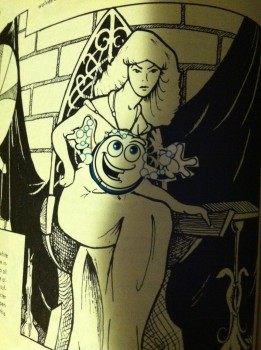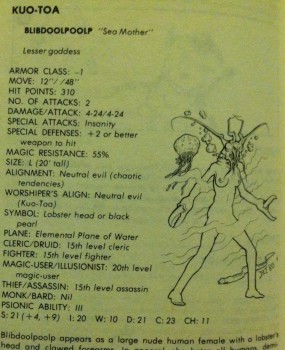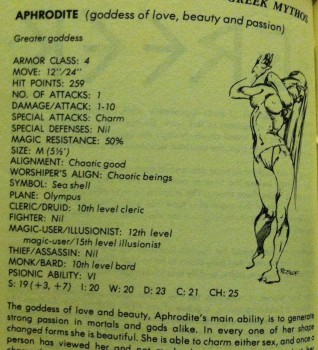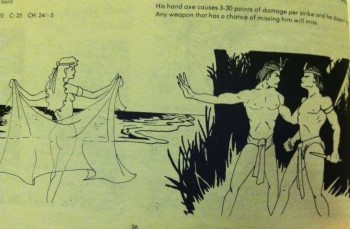OMG! Immortal Immodesty (Deities and Demigods, Part 3)

In my ongoing exploration of TSR’s first edition Deities and Demigods (1980), I must now confront the mammary in the room.
Did you ever notice there’s a fair amount of nudity in those first generation ADD books? I’m just, um, wondering if you guys did. I mean, I didn’t. I just noticed. Someone pointed it out to me — yeah! That’s the ticket! When I was twelve years old, I was much too pious to have had any impure thoughts toward Loviatar, aka Goddess of Hurt aka “Maiden of Pain.”
Okay, I may have noticed in passing that there was less modesty in those ‘70s and early ‘80s realms of fantasy, whereas with second edition on there is nary a nipple to be noticed. The cleaning up happened before the Wizards of the Coast buy-out and seems to track pretty closely with the culture in general (note many PG movies from the same era — say, the original Clash of the Titans — that couldn’t be shown on basic cable these days without heavy editing to assure that preteens aren’t sullied by viewing bare human breasts and buttocks, which they have never seen because who ever heard of the Internet?).
The interior illustrations are gorgeous. This is old-school RPG, so it’s all black-and-white line art by the likes of Erol Otus, David S. LaForce, Jim Roslof, and David C. Sutherland III.
To undress, er, address the tempestuous topic of topless deities in the temples, I must confess that, as an adolescent, I did appreciate the fact that goddesses by and large disdained mortal-kind’s prudery when it came to attire. It’s stunning, really, how many goddesses not only do not cover up their breastesses, but wear outfits that positively accentuate them.

There may be a variety of reasons for any given goddess to do this. Maybe it’s a ploy to distract from the fact that she has the head of a jackal or a snake (or a lobster, as in the case of Blibdoolpoolp, goddess of the Kuo-Toa). (There’s a story out of London about a female pickpocket who flashes her breasts at her victims after snatching their iPod or iPhone: the victims can never provide to police a description of her face.) Maybe it’s to symbolize her status as a giver and sustainer of life and sustenance to her followers. Maybe it’s just because David S. LaForce was really good at drawing breasts.
Anyway, Hasbro, the corporate deity of Wizards of the Coast, would never let such nudity fly in one of their products now. Which is ironic, when you consider that we live in the age of the Internet. And aren’t we supposed to be getting over these hang-ups about what we (and some immortal beings) look like under our clothes? Then again, it was only twelve years ago that U.S. Attorney General John Ashcroft spent $8,000 (taxpayer money!) for drapes to cover the bare-breasted statue of Lady Justice in the U.S. Department of Justice headquarters.
Bram Dijkstra, aside from having more consonants in a row than any name I’ve seen since Mister Mxyzptlk, is Professor Emeritus of Comparative Literature and Cultural History at the University of California, San Diego. In his book Naked: The Nude in America (2010), he makes this observation about our society and its attitudes toward nudity:
The mind-boggling contradictions of American culture are nowhere as obvious as in its constantly shifting attitudes toward the naked human body. During the late 1960s and early ‘70s, nudity was a relatively common sight at rock concerts and in the theater. But as recently as 2002 John Ashcroft still sought to bring modesty to a statue representing the Spirit of Justice. On display since the early 1930s in the great hall of the department named after her in Washington, D.C., the statue offended the attorney general because, in raising her arms, she had been so incautious as to let one rounded breast float free. Ashcroft retaliated by having the entire statue (and its loincloth-protected mate, the masculine Majesty of Law) hidden from sight by blue drapes — strictly for ‘aesthetic reasons,’ a Justice Department spokesperson claimed.
The drapes were removed in 2005 by Ashcroft’s successor, but this puritanical strain obviously runs deep — see overblown reaction to any infamous wardrobe malfunction that can be cited (Do you remember where you were when Janet Jackson’s nipple was exposed for half-a-second on network television? Right up there with the Challenger explosion in terms of the imprint on cultural memory, isn’t it? And that’s pretty ridiculous.)
 Professor Dijkstra goes on to note several ironies concerning the U.S. being “one of the largest exporters of images of naked bodies, which, though rarely seen on the home front, grace the covers of newspapers and magazines the world over. . . .
Professor Dijkstra goes on to note several ironies concerning the U.S. being “one of the largest exporters of images of naked bodies, which, though rarely seen on the home front, grace the covers of newspapers and magazines the world over. . . .
“And, even as their sons and daughters send nude photographs of themselves to friends over the Internet, parents everywhere continue to insist that nudity should be banned from museum walls in order to protect their innocent brood from harm. Convinced that depictions of the naked human body are bound to undermine culture and destroy the putative control of civilization over the ‘anarchy’ of erotic temptation, these parents openly celebrate family values while many of them are secretly engaging in affairs or frequenting prostitutes, only to tearfully confess their ‘sexual addiction’ or to blame the devil (usually a woman) when caught.”

In terms of the “long history of such virtuous hypocrisy in American culture” that Dikjstra examines, it may be hard to fathom how anyone could be really offended by the illustrations in DDG and The Monster Manual — they’re pretty innocuous. But during the witch-hunt launched against D&D in the ‘80s, it certainly couldn’t have helped when one’s concerned Christian mother opened DDG and saw — on top of the magic and the summoning of spirits — a lobster-headed goddess flashing her assets.
Truthfully, though, I’ve seen illustrations in children’s books from the Victorian era that are as explicit, in which mermaids and fairies in their innocence do not fret about cockle-shells or strategically placed locks of hair, unlike their later Disney versions.
For wisdom in navigating these touchy cultural waters, I think we’d best bow and seek guidance from Aphrodite or Isis — and hey, her feet are down there, buddy! Where your eyes should be when you’re supplicating a divine being!
Love these articles concerning my favorite D&D book of all time. Keep ’em coming!
As if the attraction of D&D wasn’t enough for my adolescent self, like yourself this art work sure helped as well. However, let me push back a bit.
Though I don’t find nudity in the original Deities and Demigods, or in general, to be offensive (I’ve never quite understood that claim), I do think there are issues of appropriateness (a fuzzy line to be sure) that should be considered, especially concerning children.
Surely there is a distinction between artwork/photography that displays nudity and those that display what we might call eroticism where the latter has the stronger causal effect (intentional or not) of causing sexual arousal.
Now that I’m in my 40s (even though I don’t have any children) I would be much more conscience of allowing children access to clearly erotic material. But nudity that could be parsed from eroticism I might actually encourage if for no other reason in order that nudity would not be shocking or unusual as they grew older.
That being said, I know the distinction between nudity and eroticism is not clear cut and can be subjective. Nevertheless, I think there are clear differences between, say, internet porn and say, classic Greek statues.
And just for the record, I don’t think any of the art in the original Deities and Demigods counts as erotic, or at least not clearly so.
I also want to push back against this idea of the “witch-hunt launched against D&D in the ‘80s”. I think this was always more hype than any sort of concerted effort to attack D&D.
I’m sure you can find documentation of certain people or organizations making “sabre-rattling” call to arms during the time period. But I don’t think this ever amounted to very much. Such claims remind me of the similar “Satanists are in your backyard” scare especially heightened by Geraldo Riviera’s special on Satanism back in the 80s.
My point is that the supposed witch-hunt against D&D back in the 80s is much more overblown than an actual historical reality. And I think us older gamers that remember some of that hype like to regale it as part of the legend of old-school D&D forged in fires of persecution. Great campfire fodder, but not great history.
I don’t know, James. It seemed pretty extensive to me.
James,
To respond to your two comments separately, I first want to say that I agree wholeheartedly with the points you make in the first one.
There is clearly a distinction between innocent or artistic portrayal of nudity and erotica, although granted it can be somewhat subjective. I mean, the artist’s intent is not, but interpretation by an individual audience member can be. Art such as that found in DDG is not erotic unless a female’s breast is inherently so — else medical textbooks, National Geographic Magazine, and mothers breastfeeding would have to be labeled as erotic, which is ridiculous. Of course, we have a substantial streak of ridiculous in this country (witness the recurring public breastfeeding controversies that periodically leak into the fabric of the media like a lactating mammary gland).
Judging by some examples of public art and even children’s book illustrations from the late Victorian period into the 1930s, it appears (perhaps ironically from our twenty-first-century perspective) that the culture back then had a clearer grasp of this distinction than it does now. Even while they were prosecuting literature, photography, and film as pornographic that we today would regard as tame, they apparently had no problem with topless statues and (non-erotic) drawings of breasts. Maybe this is directly related to the fact that public breastfeeding was much more common, more people shared public baths etc. Breasts really get fetishized in the ‘40s and ‘50s, and it’s from that period on that people start having palpitations at the mere thought of an exposed nipple.
My wife and I bear the responsibility of drawing that line in our house because we have children. My wife happens to be a practicing studio artist with a BA in art, so there are all sorts of art books throughout our house. My wife sometimes paints nudes in her art, and in the home library there are plenty of art model reference books. Neither of the kids has shown any prurient interest in gawking at naked pictures, but then they are both pretty young. If my boy is like I was when he turns 11 or 12, he’ll be raiding his mom’s art books right quick; this is just natural curiosity.
I don’t think seeing one of Degas’s Bathers series on the cover of a collection of Impressionist paintings is going to do any harm to or corrupt the children. On the other hand, there are graphic novels in my collection that I will not let them look at because their themes and portrayals (not just about sex) are meant for a more mature audience. My daughter is not ready for Neil Gaiman’s Sandman, and not just due to the nudity.
I think a far more harmful attitude is the religiously puritanical one that inevitably fosters the impression that the human body is dirty and shameful.
[POSTSCRIPT to this comment: My wife finds it ironic that I used Degas as an example of innocent nudity, because she points out that in his day his work was considered erotic and “right on the verge of pornography — all sorts of French women fainting when they saw his work.” Useful here to have an art major handy! Well, I guess standards do change.]
James and Jeff,
To your second comment, James, I have to concur with Jeff on this one, only because I experienced it personally. The variance in perceptions may be due to different subcultures. Obviously there were many modern, free-thinking people who went on playing D&D throughout the ‘80s and must’ve looked on all the “game-of-Satan” talk with some bemusement.
I was in a church sub-culture that was inundated with this worldview, and it had a direct and extreme impact on myself. I’ll likely go more in-depth to my personal experience somewhere down the road, but to give a summary here:
The first impact was when my best friend in junior high arrived to our session one day bearing the news that he could no longer play D&D with us, by order of his Catholic mother (who, I believe, had heard a priest rail against it in a sermon).
Then, when I was a freshman in high school, I joined this sub-culture — specifically one of the evangelical Christian stripe. I began visiting the local Christian bookstore as often as the local comic book store, and in the former there was a whole section of books condemning the evils of role-playing games (and secular rock and comic books and movies and even the Smurfs). As part of my conversion, I threw out every last one of my D&D books and dice and miniatures — a full, heavy garbage bag that also included many fantasy novels and comics (hence why I had to buy my current copy of DDG as well as many other classic tomes and modules on eBay). Only Jesus stories for me from then on, by golly!
Along with a buddy of mine who also converted to this extreme fundamentalist camp (but, like me, also later came to his senses), I spoke to a couple church youth groups and went on local Christian radio and TV programs to share my testimony as a “former Dungeon Master.” So — I confess with some embarrassment — I even played a small role in fostering this view in my own community. I didn’t start playing again until my mid-twenties, when life and college had cured me of the mental nonsense.
Again, this whole movement may have been mostly contained to a certain subset of the culture — but it’s a pretty big subset, especially in the south.
Nick,
Thanks for your thoughtful responses.
Concerning the nudity issue, I think we agree, including that the line between nudity and eroticism is not clear.
Concerning the second point: I’m sure that one could find quite a few people (within our small niche of middle-aged RPG-ers) who can give similar testimony. But, personally, I cannot relate.
I too grew up in a very conservative Christian home, but I guess my parents and grandparents were more rational concerning such issues. My fundamentalist grandmother bought me my first boxed set of D&D! In addition, I grew up in a small midwestern town. All of the friends that I had there who played D&D were also in conservative religious homes and none of them were forbidden from playing it. So I cannot give similar testimony to said issue.
I suppose if there is anything that I’m really quibbling with here it is the use of the word “witch-hunt” or similar notions like “persecution.” I can think of groups throughout history that are more faithfully characterized with such terms than 80s D&D players. By characterizing it in such a way it seems to cheapen those words in some sense.
Again, I realize there are individuals who definitely fit your description, but it’s far from clear to me whether we should infer a witch-hunt from such a sample size.
Final thought: I may be completely wrong about this. As someone who grew up in the 80s playing D&D, I’m just sharing my perspective.
I hope you do more posts on Deities and Demigods. Besides this book, another that greatly influenced me was D’Aulaires’ Book of Norse Myths. I remember having the Deities and Demigods book out as I read D’Aulaires’ because the image of the Norse gods in my head was already cemented by TSR!
James,
I agree that words like “persecution” are too strong for the ’80s D&D hysteria. Persecution is what happens to black youth when they are put in jail and marked with a lifelong criminal record for mere possession of marijuana. Being told by your parent or pastor that you can’t play a particular game probably doesn’t rise to that level.
Interestingly, however, the term “witch hunt” has a literal meaning in this context, and not just a metaphorical one. Many of the pastors I heard and authors of books I read condemning D&D explicitly argued that witch covens and devil worshippers were behind the games and using them as a recruiting tool. The witch hunt was not so much against players as against the makers of the games.
@James: “I remember having the Deities and Demigods book out as I read D’Aulaires’ because the image of the Norse gods in my head was already cemented by TSR!”
I wonder how many first-time readers of the Norse myths had the Marvel comics version of the Norse gods in their heads! (Norse pantheon as seen through the lens of Jack Kirby!)
who, I believe, had heard a priest rail against it in a sermon
I remember someone on r.g.frp saying he saw some Chick tracts in his Catholic church on the evils of D&D. He pointed out to the priest that Chick Publications has tracts on the Catholicism too. The next time he was in the church, no tracts. 😉
Jeff,
I had many of those Chick tracts and comic books in the mid ’80s. Man, Chick was down on Catholics! The Pope was the anti-Christ and the Roman Catholic church was the Whore of Babylon or something. Nutter stuff. And all the rock ‘n roll music had subliminal messages and backward masking meant to lure your brain to Satan.
A couple years ago I just had to re-aquire the infamous Chick tract “Dark Dungeons” on eBay (for a good laugh). I made sure it was the first version, which included J.R.R. Tolkien and C.S. Lewis in its condemnation of popular fantasy. Later editions of the tract, I discovered, had specific references to those two authors removed (even Chick, who had no problem bashing other Christian denominations as wolves-in-sheep’s-clothing, probably could not take the backlash from besmirching the name of one of the most popular Christian writers ever. I mean, Chick comics were being displayed in the same Christian-bookstore aisle next to The Chronicles of Narnia, and the booksellers probably didn’t appreciate his attack on one of their bestsellers. The Catholic bashing, though? No problem, apparently).
Nick: w/r/t the Norse myths, I don’t know about the players, but I’m pretty sure that the designers had read Kirby’s Thor. Sif’s described as a warrior goddess, which so far as I know isn’t in any recorded myth — but is in Kirby’s comics.
@Matthew David Surridge
That’s awesome! Time and again you see the reciprocal nature of ideas. I love it!